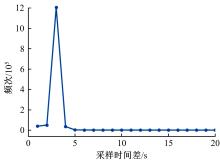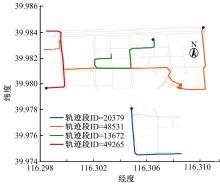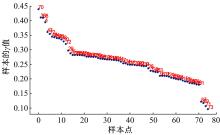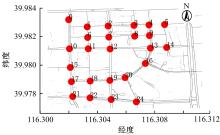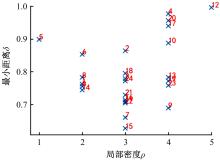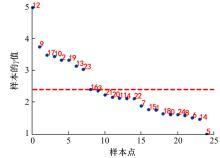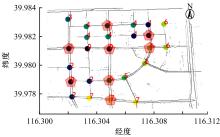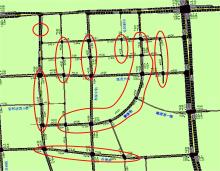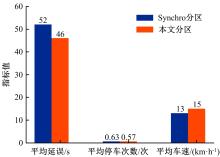吉林大学学报(工学版) ›› 2023, Vol. 53 ›› Issue (1): 124-131.doi: 10.13229/j.cnki.jdxbgxb20210513
• 交通运输工程·土木工程 • 上一篇
基于密度峰值聚类的交通控制子区划分方法
- 1.北方工业大学 城市道路交通智能控制技术北京市重点实验室,北京 100144
2.北方工业大学 信息学院,北京 100144
Traffic sub⁃area division method based on density peak clustering
Lu WEI1( ),Lei GAO1,2,Jin-hong LI2(
),Lei GAO1,2,Jin-hong LI2( ),Jian YANG1,2,Yu-lin TIAN1
),Jian YANG1,2,Yu-lin TIAN1
- 1.Beijing Key Laboratory of Urban Road Traffic Intelligent Control Technology,North China University of Technology,Beijing 100144,China
2.School of Information Science and Technology,North China University of Technology,Beijing 100144,China
摘要:
为提升区域交通信号系统的控制效率,提出了一种基于车辆轨迹数据和密度峰值聚类的城市路网交通控制子区划分方法。首先,结合轨迹数据特性并综合考虑交叉口间距、车辆延误、车队离散度等因素的影响,定义并计算了交叉口的关联度指标。其次,根据关联度指标得到交叉口的距离矩阵,作为密度峰值聚类算法的输入;针对密度峰值聚类的超参数设置问题,引入数据场理论中势能熵的概念确定最优值;同时,借鉴肘部法则的思想确定聚类中心数量。最后,将改进的密度峰值聚类算法应用于交叉口子区划分中。以北京市中关村西区真实车辆轨迹数据的实验分析表明:本文方法可以仅基于车辆轨迹数据实现城市路网交通控制子区的高效、合理划分。
中图分类号:
- U491.1
| 1 | Walinchus R J. Real-time network decomposition and sub-network interfacing[J]. Highway Research Record, 1971(366): 20-28. |
| 2 | Yagoda H N, Principe E H, Vick C E, et al. Subdivision of signal systems into control areas[J]. Traffic Engineering, Inst Traffic Engr, 1973, 43(12): 42-47. |
| 3 | Chang E C P. How to decide the interconnection of isolated traffic signals[C]∥Proceedings of the 17th Conference on Winter Simulation, San Francisco, USA,1985: 445-453. |
| 4 | 马莹莹, 杨晓光, 曾滢. 基于谱方法的城市交通信号控制网络小区划分方法[J]. 系统工程理论与实践, 2010, 30(12): 2290-2296. |
| Ma Ying-ying, Yang Xiao-guang, Zeng Ying. Urban traffic signal control network partitioning using spectral method[J]. Systems Engineering―Theory & Practice, 2010, 30(12): 2290-2296. | |
| 5 | Lin X, Xu J. Road network partitioning method based on canopy-kmeans clustering algorithm[J]. Archives of Transport, 2020, 54(2): 95-106. |
| 6 | 王力, 陈智, 刘小明, 等. 基于社区发现的交通控制子区优化方法研究[J]. 交通运输系统工程与信息, 2012, 12(6): 164-169. |
| Wang Li, Chen Zhi, Liu Xiao-ming, et al. Sub-control-area division optimization of traffic network based on community discovery [J]. Journal of Transportation Systems Engineering and Information Technology, 2012, 12(6): 164-169. | |
| 7 | Rodriguez A, Laio A. Clustering by fast search and find of density peaks[J]. Science, 2014, 344(6191): 1492-1496. |
| 8 | 淦文燕,刘冲.一种改进的搜索密度峰值的聚类算法[J]. 智能系统学报,2017,12(2):229-235. |
| Gan Wen-yan, Liu Chong. An improved clustering algorithm that searches and finds density peaks[J]. CAAI Transactions on Intelligent Systems, 2017, 12(2): 229-235. | |
| 9 | Wang S, Gan W, Li D, et al. Data field for hierarchical clustering[J]. International Journal of Data Warehousing and Mining, 2011, 7(4): 43-63. |
| 10 | Kodinariya T M, Makwana P R. Review on determining number of cluster in k-means clustering[J]. International Journal of Advance Research in Computer Science and Management Studies, 2013, 1(6): 90-95. |
| [1] | 刘东波,沈莉潇,代磊磊,陆建. 基于多目标雷达数据的单点交通信号控制方法[J]. 吉林大学学报(工学版), 2022, 52(10): 2456-2465. |
| [2] | 贾超,徐洪泽,王龙生. 基于多质点模型的列车自动驾驶非线性模型预测控制[J]. 吉林大学学报(工学版), 2020, 50(5): 1913-1922. |
| [3] | 曲大义,贾彦峰,刘冬梅,杨晶茹,王五林. 考虑多特性因素的路网交叉口群动态划分方法[J]. 吉林大学学报(工学版), 2019, 49(5): 1478-1483. |
| [4] | 吴骅跃,段里仁. 基于RGB熵和改进区域生长的非结构化道路识别方法[J]. 吉林大学学报(工学版), 2019, 49(3): 727-735. |
| [5] | 黄岚, 李玉, 王贵参, 王岩. 基于点距离和密度峰值聚类的社区发现方法[J]. 吉林大学学报(工学版), 2016, 46(6): 2042-2051. |
| [6] | 陶涛,徐洪泽. 高速列车浸入与不变自适应容错控制方法[J]. 吉林大学学报(工学版), 2015, 45(2): 554-561. |
| [7] | 段后利,李志恒,张毅,胡坚明. 交通控制子区动态划分模型[J]. 吉林大学学报(工学版), 2009, 39(增刊2): 13-0018. |
| [8] | 陈 强, 李 江, 吴 想, 闫松申. 轮胎印痕识别算法及实例分析[J]. 吉林大学学报(工学版), 2005, 35(01): 39-0043. |
|
||
